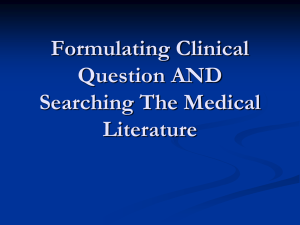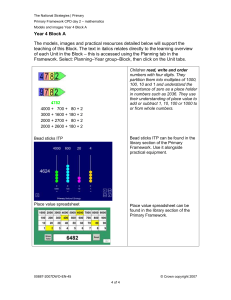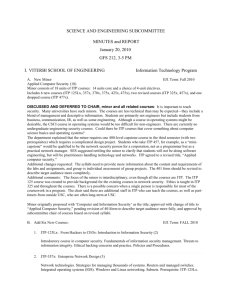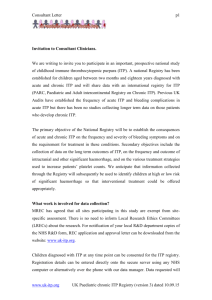The Oklahoma ITP Registry Newsletter, April 2005
advertisement
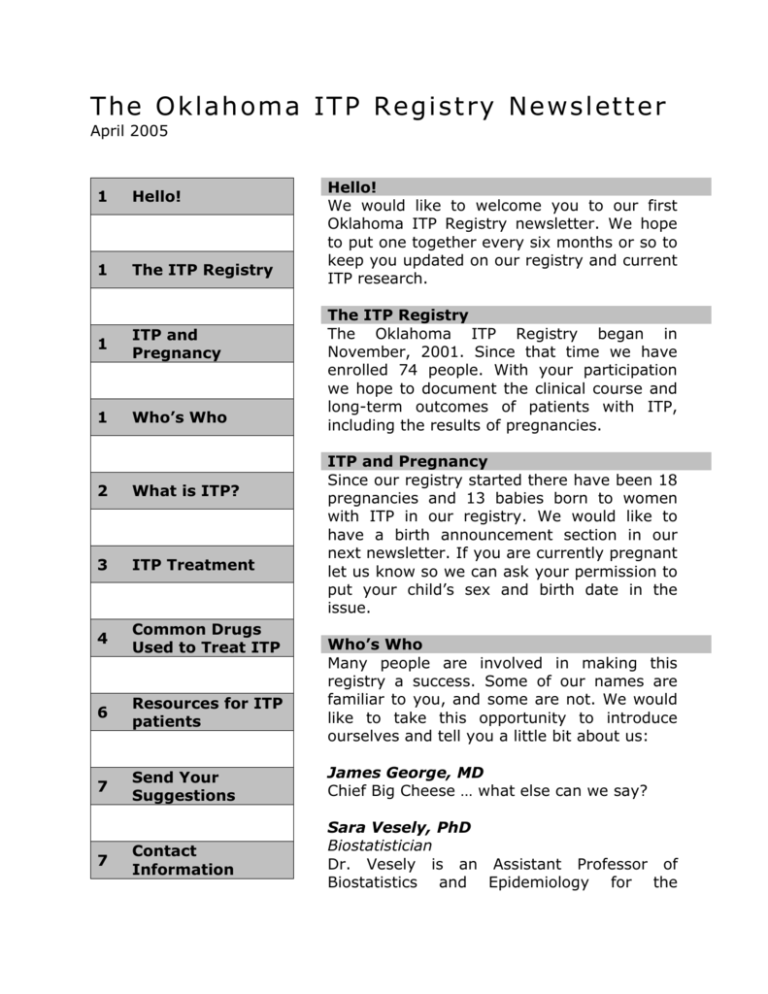
T he Ok lahoma ITP Reg is t ry N ew s let t er April 2005 1 Hello! 1 The ITP Registry 1 ITP and Pregnancy 1 Who’s Who Hello! We would like to welcome you to our first Oklahoma ITP Registry newsletter. We hope to put one together every six months or so to keep you updated on our registry and current ITP research. The ITP Registry The Oklahoma ITP Registry began in November, 2001. Since that time we have enrolled 74 people. With your participation we hope to document the clinical course and long-term outcomes of patients with ITP, including the results of pregnancies. ITP and Pregnancy Since our registry started there have been 18 pregnancies and 13 babies born to women with ITP in our registry. We would like to have a birth announcement section in our next newsletter. If you are currently pregnant let us know so we can ask your permission to put your child’s sex and birth date in the issue. 2 What is ITP? 3 ITP Treatment 4 Common Drugs Used to Treat ITP 6 Resources for ITP patients 7 Send Your Suggestions James George, MD Chief Big Cheese … what else can we say? Contact Information Sara Vesely, PhD Biostatistician Dr. Vesely is an Assistant Professor of Biostatistics and Epidemiology for the 7 Who’s Who Many people are involved in making this registry a success. Some of our names are familiar to you, and some are not. We would like to take this opportunity to introduce ourselves and tell you a little bit about us: ITP Registry Newsletter page 2 Colleges of Public Health and Medicine at the University of Oklahoma Health Sciences Center. Dr. Vesely conducts research on blood disorders. She is also involved in the College’s Teen Assets Program, which helps adolescents with decision-making skills. Dee Terrell, MPH Clinical Trials and Registry Coordinator Dee is currently pursuing a PhD in Epidemiology at the University of Oklahoma Health Sciences Center, and has chosen ITP as her research focus. Dee has been with Dr. George since August 2001 and helps conduct clinical trials as well as research blood disorders. In addition to working with blood disorders, Dee has an interest in the racial disparities of diseases. Lauren Williams Graduate Research Assistant Lauren is also a student at the University of Oklahoma Health Sciences Center, working on an MPH (Master’s of Public Health) in Epidemiology. She joined our staff in January 2003, and has participated in research. Kristina Johnson Undergraduate Research Assistant Kristina is currently a sophomore Biology major, with a pre-med focus, at Oklahoma Baptist University. She joins us during summer and winter breaks, and has researched racial disparity in ITP. Alisa Hankins, MS Graduate Research Assistant Alisa is a student of Epidemiology in the College of Public Health. She has a Master’s degree in Psychology and is interested in nutrition. Alisa joined our staff in March. What is ITP? It is nearly impossible to cope with an illness that neither you nor your family have ever heard of before. This information is written to help you understand what your doctor has told you. ITP describes an illness for which the full name is too long to remember: I is for Idiopathic, a term describing conditions without a known cause. I is also for Immune, because an abnormality of the immune system is responsible for the disease. T is for Thrombocytopenic, a term describing low platelet counts. Thrombocyte is an old name for platelet, because platelets are important for the formation of blood clots, or thrombi. In ITP the body’s immune system attacks healthy platelets causing a low platelet count. ITP Registry Newsletter P is for Purpura, a thrombocytopenia. page 3 term describing the bruises that accompany Idiopathic (Immune) Thrombocytopenic Purpura (ITP) is a disorder of the blood. In people with ITP, all of the blood cells are normal except for the blood platelets. Platelets are the tiny cells that seal minor cuts and wounds and form blood clots. A normal platelet count is 150,000 to 350,000. A person with too few platelets, such as less then 20,000, bruises easily and may bleed for a long time after being injured. Tiny red dots (petechiae) on the skin might also appear. When the platelet count is very low, such as less than 10,000, the person with ITP might have nosebleeds that are hard to stop, prolonged menstrual periods, or might have bleeding in the intestines. The cause of ITP is not known. People with ITP form antibodies that destroy their blood platelets. Normally, antibodies are a healthy response to bacteria, viruses, or other foreign material, such as an organ graft. In people with ITP, however, the antibodies attack the body's own blood platelets. The abnormal immune reaction against the body’s own cells is called autoimmune. Examples, of other autoimmune diseases are thyroid disorders and lupus. To diagnose ITP the physician will take a medical history and perform a thorough physical examination. A careful review of medications the patient is taking is important because some drugs can be associated with thrombocytopenia. A complete blood count will be done. A low platelet count will establish thrombocytopenia as the cause of purpura. Some hematologists will next perform a bone marrow examination to verify that there are adequate platelet-forming cells in the marrow and to rule out other diseases such as metastatic cancer (cancer that has spread to the bone marrow) and leukemia (cancer of the blood cells themselves). Another blood sample may be drawn to check for other conditions sometimes associated with thrombocytopenia such as lupus and infection. However, in many patients the diagnosis of ITP is clear just from the history, physical examination, and initial blood counts, and additional blood tests or bone marrow are not needed. ITP is sometimes an acute illness in which platelet counts recover spontaneously. This is most common in children. In most adults, ITP is a chronic illness lasting for many years. ITP Treatment The goal of treatment for ITP is only to maintain a safe platelet count-to prevent bleeding. The goal is not to achieve a normal platelet count. Because many children recover spontaneously within several weeks or ITP Registry Newsletter page 4 months, they are often observed carefully without treatment, even if their platelet count is very low. However, because the course of ITP in adults is often prolonged, some treatment is appropriate if the platelet count is very low and bleeding symptoms are present. Adults without bleeding symptoms, and who have platelet counts over 30,000, may be safely observed without any treatment. When an adult patient is first diagnosed with ITP and a platelet count less than 30,000, some treatment is appropriate. Most adult patients are treated first with steroid medicines that suppress the immune system and therefore prevent the increased platelet destruction. Treatment with steroids is successful in bringing platelet counts to safe levels in most patients with ITP. However, steroids can only be taken for a short time because they have serious side effects (see below). If additional treatment is needed, more careful decisions have to be made. Common Drugs Used to Treat ITP As you know, we have bombarded you with questions about medications you have taken to treat your ITP. Below are six main categories of available treatments and their most common side effects. 1) IMMUNOSUPPRESSANT THERAPIES Immunosuppressants decrease the effects of your body’s immune system. Steroids, such as prednisone, dexamethasone, and danazol, are common immunosuppressants. Other immunosuppressive medicines are azathioprine and cyclosporine. Immunosuppressants raise the body’s platelet count by reducing the activity of the immune system. All of these medicines are oral tablets. a) Prednisone and Dexamethasone (Decadron). Common side effects are insomnia, nervousness, nausea, upset stomach, fatigue or dizziness, muscle weakness, problems with diabetes control, increased hunger or thirst, acne, increased hair growth, thinning of skin and roundness of the face. Long-term use can result in cataracts, glaucoma, and osteoporosis. b) Danazol. Common side effects unique to danazol are oily skin and hair, puffiness, weight gain, deepening of voice, headaches, sweating, hoarseness, unnatural hair growth, decrease in breast size, and vaginitis. c) Azathioprine (Imuran). Common side effects are nausea, vomiting or loss of appetite, hair loss, rash, sores on the lips or inside of the mouth, unusual bleeding or bruising, and an overall feeling of illness. d) Cyclosporine. Common side effects are increased body hair growth, tremors, gum problems, high blood pressure, decreased appetite, and tingling or numbness. ITP Registry Newsletter page 5 2) SURGICAL THERAPY A splenectomy is the surgical removal of the spleen. The spleen is the site of platelet removal. Side effects of a splenectomy include decreased immune system function. 3) CHEMOTHERAPY Chemotherapy drugs work to stop the rapid division of cells and therefore also suppress the immune system. Since ITP involves a hyperactive immune system that produces autoantibodies at a rapid rate, chemotherapy can be used to suppress those cells. Vincristine, vinblastine, and cyclophosphamide are examples of chemotherapy drugs used to treat ITP. a) Vincristine/Vinblastine. Given by intravenous (IV) infusion. Common side effects are constipation or abdominal cramps, nausea, vomiting or loss of appetite, inflammation and sores on the lips or inside of the mouth, vision problems, jaw, throat, bone, back, or limb pain, headache, temporary hair loss, redness, burning, or irritation at the injection site, depression, dizziness or vertigo, hearing loss or changes in hearing, weakness, and tiredness. b) Cyclophosphamide (Cytoxan). Can be given either as oral tablets or IV infusion. Common side effects are nausea, vomiting or loss of appetite, mouth sores, abdominal pain, diarrhea, temporary hair loss, rash, changes in nails and skin color, and temporary or permanent sterility. 4) NEW BIOLOGICAL THERAPY Rituximab (Rituxan) is an important new biological therapy. It reduces the number of B cells in your body. B cells are the type of white blood cells that produce antibodies. Since rituxan reduces the number of B cells, it reduces the number of cells that produce antibodies, including the antibodies that attack platelets. Rituximab is given as four weekly IV infusions. Common side effects are nausea, vomiting, headache, weakness, flushing, and dizziness, mostly with the first IV infusion. 5) EXPERIMENTAL THERAPY AMG 531 is a new drug currently in development by the pharmaceutical company, Amgen Inc. AMG 531 works by stimulating platelet production in the bone marrow, in contrast to all other ITP treatments which decrease platelet destruction. AMG 531 is given as an injection under the skin. Current clinical trials have shown no side effects and the drug seems to work in both patients with and without splenectomy. ITP Registry Newsletter page 6 6) OTHER THERAPIES These are used when the platelet count needs to be increased, but only for a short time. a) IV Immune Gamma Globulin - IVIg. IVIg is a solution of globulins from normal human blood plasma containing antibodies. Globulins are simple proteins that provide immunity against disease. Common side effects are backache or pain, headache, joint pain, muscle pain, nausea, vomiting, chest or hip pain, leg cramps, redness, rash, or pain at the site of injection, blurred vision, confusion, dizziness, faintness or lightheadedness when getting up from a lying or sitting position suddenly, chills, fever, sweating. b) Anti-D (WinRho). A sterile freeze-dried gamma globulin fraction containing antibodies to the Rh(D) blood group. Anti-D coats normal red cells with anti-D the red cells are then destroyed by the spleen, therefore these red cells compete with the patients platelets for destruction by the spleen. Usually the coated red cells succeed in blocking the spleen’s destruction of platelets, thus increasing platelet counts. There are many more red cells than platelets, therefore additional red cell destruction is rarely a problem. Anti-D is given by IV infusion. Common side effects are fever or chills, wheezing, muscle aches or pains, back pain, and pain or tenderness at the injection site. 7) DIET AND HERBAL REMEDIES. Many diet and herbal remedies are proposed, but we believe they are not effective for the treatment of ITP. More about this topic can be found at the following link: www.itpsupport.org.uk/american/american_mar2003.htm Resources for ITP Patients Visit our website, Platelets on the Internet, at http://moon.ouhsc.edu/jgeorge. Below are summaries of the stories found on our site – you can read the full versions online (names have been changed to protect confidentiality). a. Christy has lived with ITP since she was 11 years old. Despite low platelet counts she works full time as a social worker, is getting a master’s degree, and is a full time mommy. Christy’s advice to patients with ITP is that, “patients should not get too consumed with the diagnosis and literature. Take it day-by-day and not get too overwhelmed with everything. Also find a physician you can trust and who is knowledgeable about the disease.” b. Crystal was 75 when she was diagnosed with ITP. Crystal has an interesting story about the options of when to treat and when not to treat ITP. Crystal’s advice for people with a new diagnosis of ITP is, “Have a positive outlook on it, have good faith in the Lord, and be optimistic.” ITP Registry Newsletter page 7 c. Rosie was diagnosed with ITP when she was 46. Rosie’s ITP has been in remission since she had her splenectomy. However, she had some rough times between diagnosis and remission. Advice that Rosie would offer to someone with a new diagnosis of ITP: "Be patient." She believes that it is only a matter of time before "they’ll get you on a right combination, and you will get better." She also adds, "Avoid steroids if you can, they are the worst part." There is also an informative website from the United Kingdom you can visit at www.itpsupport.org.uk. This site includes a support group with newsletters, publications, and information on ITP. Dr. George contributes “An American Perspective” found on this page, where you can find additional topics about ITP. www.itpsupport.org.uk/american.htm Send Your Suggestions Is there anything you’d like to see in the next newsletter? We’d like to hear from you! Please contact us if you have any suggestions as to what you would like to see in this newsletter in the future either by emailing Dee Terrell at deirdra-terrell@ouhsc.edu or calling at (405)271-8001 extension 48386. Contact Information Phone: (405) 271-4222 Mailing address: James George, MD Attention: ITP Registry OU Health Sciences Center Hematology-Oncology Section P.O. Box 26901 Oklahoma City, OK 73190 website: http://moon.ouhsc.edu/jgeorge/ITP1.html The Oklahoma ITP Registry James George, MD OU Health Sciences Center Hematology-Oncology Section P.O. Box 26901 Oklahoma City, OK 73190
